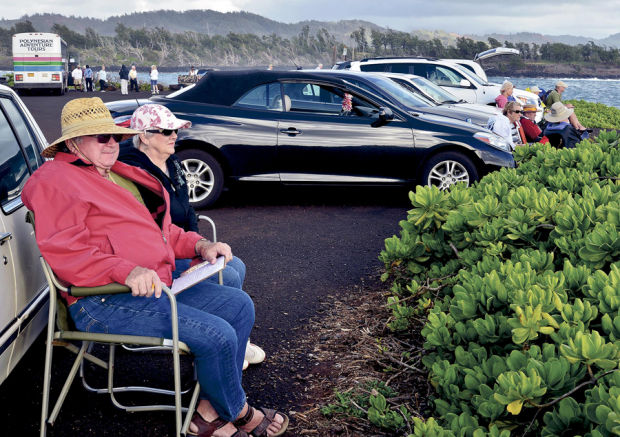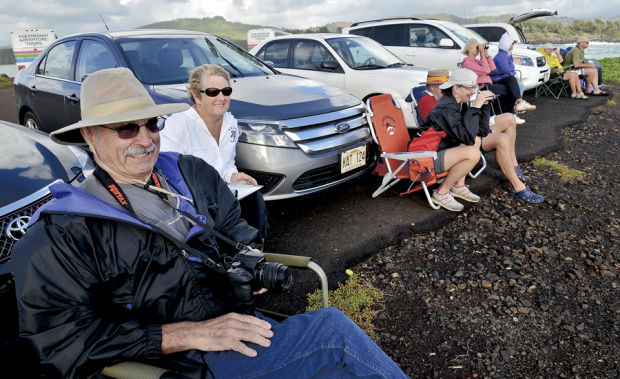LIHU‘E — Volunteers were up on Kaua‘i, but whales were not Saturday, as the Hawaiian Islands Humpback Whale National Marine Sanctuary hosted the second of three Ocean Counts. On Kaua‘i, 160 volunteers turned out for the count at 15 sites
LIHU‘E — Volunteers were up on Kaua‘i, but whales were not Saturday, as the Hawaiian Islands Humpback Whale National Marine Sanctuary hosted the second of three Ocean Counts.
On Kaua‘i, 160 volunteers turned out for the count at 15 sites — from the Lumahai Lookout through the Pacific Missile Range Facility at Mana — recording data at 15-minute intervals.
But the whales were not seen, perhaps hidden from view from the blustery weather that generated haphazard ocean swells and whitecaps.
Kaua‘i recorded an average of four sightings per 15-minute interval, down from the average of seven sightings during the Jan. 26 count.
However, both O‘ahu and the Big Island reported increases. O‘ahu increased from the average of two on Jan. 26, to three sightings; the Big Island reported seven sightings per 15-minute intervals, an increase from the four it recorded in January.
“We’ve seen eight actions, but only two whales,” said Ralph and Carol Stewart of Lihu‘e, who were helped joined by Ralph’s cousin from Canada. “Actions are things like blows. There’s been a lot of them, but only two whales.”
Statewide, more than 650 volunteers gathered data from the shores of O‘ahu, Kaua‘i and Hawai‘i Island, said Christine Brammer, the communications coordinator for the Hawaiian Islands Humpback Whale National Marine Sanctuary, in a release.
Volunteers collected data from 57 sites statewide and a total of 287 whales were seen during the 9 to 9:15 a.m. time period, the most of any time period throughout today’s count, Brammer said. Weather conditions caused cancellations at a few sites, but overall, viewing around the state was fair.
“It was a blustery day with some white caps and occasional rain squalls at many sites,” said Jean Souza, the Kaua‘i program coordinator for the whale sanctuary, in an email. “This affected everyone’s ability to see humpback whales. The ocean count volunteers are a very hardy bunch, everyone bundled up in response to the weather.”
Souza said in addition the whale sightings, volunteers also observed turtles, seabirds, including albatrosses, frigate birds, tropic birds, boobies, spinner dolphins and flying fish.
Alexandra and Gus Hildebrandt of Edmonton, Canada, were volunteering at the Ahukini Pier site, their first ocean count.
“We’ve come to Kaua‘i for four years with each time, staying longer and longer,” Alexandra said. “We thought we would do some volunteering to meet new people and have some new experiences. We found the ocean count through the Internet and we’ll be back for the March count, since we leave on April 8.”
Brammer said the next Sanctuary Ocean Count is scheduled for March 30 and people can visit www.sanctuaryoceancount.org for more information on becoming a volunteer.
“We started training five years ago,” said Marilyn and Steven Gagle of Muskegon, Mich. “This is our fourth year doing this. It’s our favorite day of the year.”
The volunteers at Ahukini Landing, headed by Margo Goosen, site leader, had one of the lesser productive sightings, reporting an average of one sighting in a 15-minute interval.
The most productive site on Kaua‘i was Crater Hill in Kilauea, where nine sightings were reported in a 15-minute interval, up from the six sightings in January. The PMRF site reported eight sightings, down from the 16 it observed in January.
The preliminary figures on Kaua‘i show the same average of four sightings for 2012, and down from the five sightings for the same count in 2011.
“The activity is usually the heaviest during the first count,” said Margo Goosen, the site leader at Ahukini Landing. “It usually tapers off after that.”
In addition to data collected, count volunteers distributed whale education at Kaua‘i sites to 368 people, down from the 406 people who got education in January.
The Sanctuary, a partnership between the state and federal governments, protects humpback whales and their habitat in Hawaiian waters where they migrate each winter to mate, calve, and nurse their young.
Visit www.hawaiihumpbackwhale.noaa.gov for more information.



